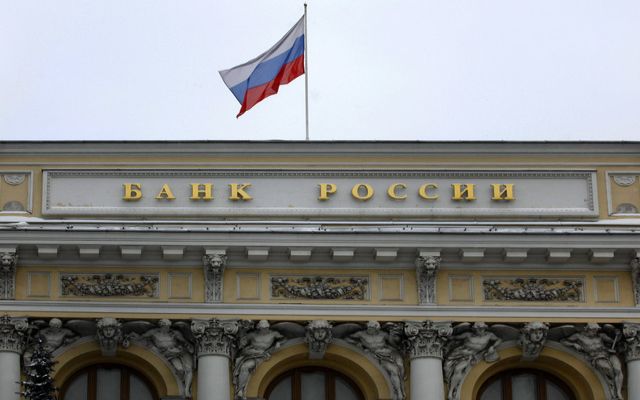in caricamento ...
Anche la RUSSIA è partita con le bombe di liquidità
La banca centrale russa (CBR) si inventa un TLTRO stile BCE ed eroga al canale bancario 1.000 miliardi di rubli. Comunque vada, sarà un successo?
Ennesimo tassello in un quadro che ormai raggiunge tinte surreali.
Già vi abbiamo sommerso di post su FED e quantitative easing, con ulteriori articoli sulla politica monetaria ultra-agressiva della Banca del Giappone, e non per ultimo i progetti bellicosi di Mario Draghi e del suo progetto di gonfiare il bilancio BCE a 3.000 miliardi di Euro.
Ma cari amici, ovviamente, non finisce qui. Tralasciamo per un attimo anche le campagne di Gran Bretagna (la BOE ha anche dato il suo) e le “fosche operazioni “ dell’altro colosso che manca all’appello, la PboC (banca centrale cinese).
In un mercato che ormai è sommerso dalla liquidità che viene generata per sostenere il canale bancario, nella speranza che poi questo denaro arrivi anche all’economia reale, ci ritroviamo con una nuova protagonista.
Salutiamo con un inchino l’arrivo sulla piazza di Misha che ci presenta la CBR, la banca centrale russa, che non vuole assolutamente essere da meno e che mette in piedi un’operazione “monstre”.
Con un’economia russa in balia della speculazione e delle svalutazione del rublo, la CBR mette sul piatto la bellezza di 16.5 miliardi di USD (1.000 miliardi di rubli): siamo lontani dai numeri del TLTRO europeo, ma è comunque un segnale chiaro che ormai la recessione si combatte con le bombe di liquidità.
Come detto si spera che questo denaro, elargito al canale bancario a partire dal 2015, venga poi girato all’economia reale, in difficoltà anche per via dell’embargo. Ma come sempre nulla garantisce il buon esito dell’operazione. Si spera in un esito simil QE della FED. Ma loro sono gli USA, con un loro modello economico e delle dinamiche non replicabili altrove (anche in Eurozona).
Più che fare gli auguri a tutti di una buona riuscita….
STAY TUNED!
(Clicca qui per ulteriori dettagli)
Segui @intermarketblog
(Se trovi interessante i contenuti di questo articolo, condividilo ai tuoi amici, clicca sulle icone sottostanti, sosterrai lo sviluppo di I&M!). E se lo sostieni con una donazione, di certo non mi offendo…
La tua guida per gli investimenti. Take a look!
Questo post non è da considerare come un’offerta o una sollecitazione all’acquisto.
Informati presso il tuo consulente di fiducia. Se non ce l’hai o se non ti fidi più di lui,contattami via email (intermarketandmore@gmail.com).
NB: Attenzione! Leggi il disclaimer (a scanso di equivoci!)
la speranza che i soldi della liquidità arrrivino all’economia reale?boh, perchè arrivi lo devono decidere. dai fatti ci stanno prendendo per i fondelli su questo tema
in quanto alla guerra del petrolio non mi ancora chiaro chi sia il burattinaio, nonostante mi sia letta in questi gg dozzine di articoli sullo shale oil, sui costi di produzione per le varie nazioni, sull’ucraina, ecc
Non c’è un unico burattinaio, è come con le nuvole quando le guardiamo, razionalizziamo e cerchiamo di riconoscere figure…
Sono invece oggettive le linee di tendenza attuali sulla quantità di energia sempre più elevata da investire per avere un differenziale energetico sempre più basso utilizzabile.
E’ anche oggettivo che il sistema economico-finanziario e il ciclo economico non sono cambiati nella loro natura, a un ciclo ne segue un altro…
Nessuno sa a livello di dati empirici quale è lo stato reale delle cose sia sulle risorse che sulla quantità di scommesse realmente perse sul futuro.
Penso che in linea teorica il sistema si assesterà ad un livello più basso e ci lascerà tutto il tempo per trovare una soluzione.
Il vero rischio nel breve e medio periodo è quello geopolitico e di disintegrazione sociale che generebbero il crollo delle filiere produttive e la conseguente difficoltà a trovare soluzioni ed è di questo che dovremmo preoccuparci.
Comunque male che vada c’è sempre l’americano che salva il mondo quando si mette troppo male, almeno è così che se la raccontano.
…” (…) we can expect that we will look towards some of those Global risks much more closely; they will figure more prominently in the stress.
And given the footprint of some of our Largest Banks in Asia, you would expect that – and given the risk profile in Asia, quite frankly – you can expect that would be a component of it – [ see to page 2 in the (next) link * ]. “…
(…)
…” In terms of Russia specifically, I think we have to recognise the direct exposure of the UK and UK institutions to Russia is very modest.
If you look across the Banking Sector, it’s around 2.5% of Banks’ Equity Capital.
Exports to Russia, pre-sanctions, less – about 1.5%.
So relatively limited ties, relatively limited direct investment despite the headlines of Russia – Russian entities into the United Kingdom.
So there’s relatively modest direct effect. And the situation in Russia is somewhat “unique”.
There certainly are other major oil-producing Nations that have some pressure from movements in oil prices, but obviously few of them are subject to sanctions at the same time.
So there are bigger adjustments going on in Russia, arguably, than in some other major “emerging markets” – [ see to page 3 in the (next) link * ].
l- – – – –
[*] M. Carney (Bank of England, Governor, the), “Financial Stability Report, December 2014 – [in] Press Conference”, London: December 16, 2014
http://www.bankofengland.co.uk/publications/Documents/fsr/2014/conf141216.pdf
– – – – -l
London Renminbi (RMB) business volumes January-June 2014[§], provides the latest data on the development of the London RMB market and growth trends observed since 2012.
It covers the first half of 2014 and gives an update on three principal RMB product and service categories:
a- trade related services,
b- foreign exchange (forex),
c- deposits.
The data is collected in a way designed to capture London’s identity as a leading centre for RMB business and is produced in connection with the City of London initiative “London as a centre for RMB business”.
The role of the City of London initiative on London as a centre for RMB business is to consider practical measures to support the development of London’s RMB markets.
Launched on 18 April 2012, it aims to:
-1- provide leadership to the wider financial markets on the technical, infrastructure and regulatory issues relevant to the development of the RMB product market in London;
-2- advise Her Majesty’s Treasury (HM Treasury) on maximising London’s capacity to trade, clear and settle RMB and articulate practical next steps and long term aims for the development of the RMB market in London.
Additionally, the group advises HM Treasury and other United Kingdom (UK) Authorities on any financial stability concerns the members may perceive;
-3- develop and maintain, as appropriate, a private sector dialogue on the international RMB market with regulators in Hong Kong and Mainland China to complement that which is already maintained by the UK public sector.
The Public Policy slant seems, for the moment, to have shifted away from the establishment of an integrated Global settlement system known as the Cross-border Inter-bank Payments System (CIPS) toward a Global network of local Chinese clearing Banks located in the main financial centres.
This would be a marked change in direction, though it doesn’t detract from the overall goal of the Chinese Authorities to continue to move toward the RMB becoming a fully tradable Global currency.
This coupled with gradual relaxations of the barriers to investment flows, such as through extension of the Renminbi Qualified Foreign Institutional Investor (RQFII) investment quotas, will eventually fully integrate the Chinese capital market into the World Market.
The/This latest survey shows a continuation of the rapid growth of RMB activity in London.
In the key area of forex/risk management, rapid growth has continued in the first half of 2014.
Forex transactions have grown particularly rapidly with daily spot trading in the first half of 2014 increasing by 160% over the level in 2013 and overall forex activity increasing by 116%.
Looking back to the first of the surveys covering 2011, spot forex trading per day in the first half of 2014 was almost 20 times the level of 2011.
The findings have also shown changes in the mix of products being used as the market experiments and develops.
Examples include the relative decline (but continued absolute growth) of non-deliverable forex products and the shift away from letters of credit towards other forms of trade finance.
Overall, the period covered in the/this report was marked by a high level of activity from the Chinese Authorities to expand the use of the RMB, leading to substantial improvements in the trading, clearing and facilitation of the Chinese currency.
In addition a number of agreements and partnerships were reached which although undoubtedly helpful in building market confidence, may take time to have a practical impact.
The rapid growth shown in deliverable forex products in the latest half year represents a continued acceleration in RMB trading growth.
This is reflected in all products as Chart 2.2 [“Trading in deliverable RMB denominated foreign exchange products” – see to page 12 / 17 (or 14 / 20) in the link § at the end] illustrates.
Comments suggest that the/this growth is being experienced throughout the market as the growth in trading is encouraged as the RMB moves towards eventual convertibility.
Respondents have suggested that RMB trading is becoming increasingly mainstream with substantial two-way order flow meaning that order matching is increasing, leading to lower costs of trading.
Chart 2.3 [“Offshore RMB forex – business done in other centres” – see to page 13 / 17 (or 15 / 20) in the link § at the end] shows the results for the four main classes of deliverable forex in the first half of 2014 and compares this with earlier data (shown with fainter shading).
The H1-2014 results show that for spot trading the respondents conducted 58% of their offshore RMB business in London.
The figure
– for forwards was 52%,
– for swaps 35%,
– for options 25%.
Compared to previous results the figures seem relatively stable – with slightly more variation in the options percentage – indicating that the “Global market for RMB forex trading is expanding at similar rates to those seen in the London market”.
Essentially, “the pie is growing and London is sustaining its position”.
Banks trading in London continued to execute over 50% of their offshore RMB spot trades in London.
The London percentages haven’t shown much movement since the measure was introduced in 2012 indicating that the Global market in RMB forex is expanding at about the same rate as the London market.
The level of London RMB deposits at June 2014 was ¥25.4 billion, a significant (74%) rise from the end of 2013.
Within the total, the main growth was in corporate deposits, which totalled ¥16.7 billion and reflected increased use by both UK and Chinese corporates.
°l°
^_The pie is growing and London is sustaining its position_^
°l°
l- – – – –
[-§-] Bourse Consult, “London Renminbi (RMB) business volumes: January to June 2014”, [Policy Practitioner Paper] – City of London Corporation RMB series, 2014: December 15, 2014
– – – – -l
? Who takes care of the interests – in the “game” – of the European Union (EU) ?
サーファー © Surfer [!Deutschland – nUr!]
idleproc@finanza:
il crollo delle filiere produttive e la conseguente difficoltà a trovare soluzioni ed è di questo che dovremmo preoccuparci.
Forse con il sistema sovraproduttivo attuale ti salvi/sopravvivi mi preoccupo di più delle eventuali ” MANUNTENZIONI ” dei SERVIZI PUBBLICI/o privatizzati. L’acqua dal rubinetto non è detto che scenda PER SEMPRE anche se noi lo diamo per SCONTATO ( e domani salato ).
Danilo LTRO è stato fatto perché il sistema bancario russo rischia il collasso a causa delle sanzioni.
Tra i tanti questo articolo della settimana scorsa spiega abbastanza bene i collegamenti:
http://citywire.co.uk/new-model-adviser/news/stop-worrying-about-the-rouble-russia-s-real-problem-is-its-banks/a789653
Per chi non conoscesse l’inglese spiego brevemente che le aziende russe hanno circa 35 miliardi di obbligazioni denominate in $ che scadono a dicembre… e la recente svalutazione ha aggravato la problematica del pagamento (avevo accennato nei giorni scorsi in diversi miei commenti tale rischio) rendendolo di fatto molto ma molto più oneroso (visto che già era oneroso per le sanzioni imposte alle aziende).
Ecco perché la banca centrale ha compiuto un (disperato e ritengo abbastanza incauto) forte rialzo del tasso di sconto, oltre all’invito dello stesso Putin al rientro di capitali in Russia.
La Cina con il recente accordo di swap è intervenuta rapidamente in soccorso… anche per tutelari i contratti in essere con le sue aziende (in modo che non vengano penalizzate da eventuali default bancari).
Ieri ad esempio ne è avvenuto il primo: si tratta della 32esima banca in termini di capitalizzazione:
http://www.washingtonpost.com/blogs/wonkblog/wp/2014/12/22/russias-financial-crisis-just-claimed-its-first-victim-a-bank-with-bruce-willis-ads/
Siamo di fronte ad una vera e propria guerra mondiale finanziaria… almeno tra superpotenze economiche.
Direi che la situazione è molto fluida anche dopo le dichiarazioni dello stesso ministro saudita del petrolio dei giorni scorsi dove dichiara che un petrolio a $40 sul breve termine non crea problemi, visto che non richiederebbe una riunione dell’OPEC prima del prossimo giugno!
Non so se sia da interpretarsi come un invito agli USA per spingere ancora più in basso il prezzo del petrolio… in modo da estremizzare in un rush finale tale guerra finanziaria (ovviamente a scapito principale della Russia). Ma lo stesso può considerarsi anche come invito alla stessa Russia di resistere anche a quel prezzo al fine di far crollare l’industria dello shale gas americano straindebitata.
Fate vobis…
Assolutamente si, il TLTRO ha questo fine in Russia. PErò volevo far notare come oermai bombardare il mercato di liquidità sia “the new normal” in ogni dove.
Qui trovare altre informazioni più recenti, sulla fluidità della situazione:
http://www.bloomberg.com/news/2014-12-23/russia-lawmakers-pass-bank-support-measures-after-rescuing-trust.html
Grazie come sempre, Surfer.
La guerra contro la Russia fredda o calda, di fatto non si è mai interrotta, è una questione strategica.
La fine che gli vogliono far fare è quella della ex-Jugoslavia che ne è stata una delle fasi, disintegrare la Federazione e aver campo libero con governi sostanzialmente assoggettati.
Poi toccherebbe alla Cina e già oggi a stati-nazione dell’America Latina.
Con il “campo libero” da impedimenti, ipotizzano anche di darsi una sistemata alla finanza spalmando il problema come fatto finora.
Papale, papale, le risorse che gli servono anche per il controllo militare globale, sono fornite dal Pantalone globale.
Questa è l’ideona e penso che se la stiano giocando tutta prima che gli possa crollare il baraccone finanziario globale.
Come sempre, è una questione di tempi.
Comunque gli attori in gioco sono molteplici, non è uno solo e hanno potenziali interessi divergenti.
Storicamente le guerre economico-finanziarie grandi o piccole hanno sempre preceduto o sono state contemporanee a quelle sul campo e ci hanno guadagnato sopra sempre gli stessi che ne sono stati anche l’origine.
Speriamo che la “situazione fluida” resti tale a lungo e che rinsaviscano nel frattempo.
Molto interessante: il processo di deleveraging più veloce della storia.
* * *
CBR just released it’s preliminary estimates of Russia’s total external debt (including corporates and everything) as of 01.01.2015
http://cbr.ru/statistics/print.aspx?file=credit_statistics/debt_est_new.htm&pid=svs&sid=itm_43952
Data reveals incredible pace of Russia’s external debt deleverage. Total debt as of 01.01.2015 fell to USD599bn versus USD728bn as of 01.01.2014 and peak value of USD732bn as of 01.07.2014 shortly before sanctions against financial sector were implemented. So over just 6 months external debt fell by some USD132bn! or just around 18%. I doubt world has ever seen such fast deleverage in absence of defaults and restructuring!
The bulk of deleverage came in 4Q (around USD80bn). The sectors that delevered the most are predictibly corporations (other sectors – USD74bn over 6 months) and banks (USD38bn). Another USD13bn of debt were shaved off by OFZ redemptions and devaluation in dollar terms. On the corporate sector most of decline is explained by decline in external loans and debt obligations to direct investmentors. There is no break-down on banking sector but probably the decline was due to international banks cutting off financing and margin calls on various derivative products that was in essence equivalent of debt redemption acceleration.
Now you probably understand, why ruble performed so badly. The data once again shows that external debt deleverage is not a joke. Credible CBR FX-refinancing facilities is a key to financial stability in 2015.





Forse sono gli unici che faran qualcosa di buono. Mi ricordo quando da giovani di usava dire ” siam presi dalle bombe ” …. è rimasto tutto com’era nulla è cambiato.